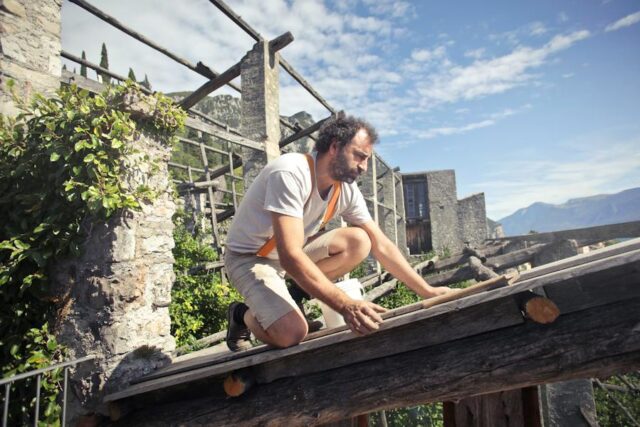As homeowners, it’s crucial always to keep an eye on the condition of our roofs. After all, they protect us and our loved ones from harsh weather conditions and provide a sense of security for our homes. But with constant exposure to the elements, wear and tear is inevitable. The key is being able to recognize when these signs need attention before they become larger and more expensive problems in the future. If you’ve noticed leaks, missing shingles, or higher energy bills, this blog post is for you. Learn about warning signs your roof needs repair and how timely action can save you time, money, and stress.
1. Missing or Damaged Shingles
One of the most overt signs that your roof may require repair comes in the form of missing or damaged shingles. Shingles are essential as they serve as your home’s primary defense against environmental elements. Over time, harsh weather conditions can result in shingles becoming cracked, loose, or completely dislodged. If you notice bare spots or inconsistencies in the shingle pattern on your roof, it’s a strong indicator that repairs may be necessary.
Damaged shingles can jeopardize your roof’s integrity. Curled, buckled, or worn-out shingles may cause water infiltration, leading to mold, leaks, and interior damage. Regular roof inspections by a leading roofing contractor, especially after storms, can catch minor shingle issues before they become major problems. This assessment ensures your roof is in optimal condition, providing peace of mind.
2. Sagging Roof
A sagging roof is a concerning issue that needs urgent attention. It usually indicates a structural problem, possibly with the rafters or decking in the attic or, in severe cases, with the home’s foundation. A clear sign of a sagging roof is a noticeable dip or curve in the roof’s slope. If you see the roof sagging from the outside or notice a bend or depression inside your attic, it means the roof’s structure is compromised and requires immediate repair.
Ignoring a sagging roof can cause serious problems. Over time, it may worsen, leading to catastrophic structural failures like roof collapse. If your roof sags, contact a qualified roofing contractor immediately. They’ll assess the severity, identify the cause, and recommend the best solution. Acting swiftly can prevent further damage, safeguard your property, and save you from costly repairs later on.
3. Roof Leaks
Water stains can be on your ceiling or walls or, in more conspicuous cases, water dripping inside your home during heavy rains. It’s essential to understand that even a small leak can be a significant problem. Water intrusion can cause severe damage to your home’s interior, including mold growth, damaged insulation, and potential structural damage if left untreated.
Locating the source of a roof leak can be challenging. Water can enter at one point and flow to another before showing signs, which can mislead homeowners. To accurately identify and fix the leak, a professional inspection is advised. Detecting and repairing roof leaks early can prevent more severe issues, preserve your home’s structural integrity, and save you on repair costs.
4. Mold or Moss Growth
In damp climates, moss can grow on the shingles, trapping moisture against the roof surface. Over time, this trapped moisture can lead to accelerated wear and tear, potentially leading to leaks or structural damage. Moss growth is typically more prevalent on the north side of roofs or in heavily shaded areas, and while it can be cleaned off, it’s critical to address the root cause to prevent regrowth.
Mold growth, often seen as black streaks on your roof, can indicate excessive moisture and poor ventilation. It not only affects shingle longevity but also poses health risks, especially for those with allergies or respiratory conditions. To address this, a professional assessment is crucial. They can recommend solutions like improving attic ventilation or installing zinc strips at the roof peak to control and prevent mold growth.
5. Granules in Gutters
If you find granules in your gutters, it’s a sign that your roof may need repair. Granules are small particles that protect your shingles from UV rays. Aging shingles lose granules, which end up in your gutters during rainstorms. Increased granule loss suggests shingles are nearing the end of their lifespan and should be replaced.
However, finding some granules in the gutters after a severe storm or new roof installation is only sometimes concerning. It’s when you consistently notice granules or if there’s a sudden increase in volume that you should be alarmed. If you suspect excessive shedding of granules, contact a professional roofer for inspection and possible shingle replacement, if needed.
6. Damaged Flashing
Flashing is a crucial part of your roof’s defense system, typically installed around skylights, chimneys, and where the roof meets the wall. Its main function is to redirect water and prevent leaks. Damaged flashing, such as bending, cracking, rusting, or missing parts, can make your roof highly vulnerable to leaks, even if the rest of the roof is in good condition. Regular inspections can identify damaged flashing early, preventing further issues.
If you notice damaged flashing on your roof, it’s crucial to repair or replace it immediately. Neglecting this can lead to water seeping into your home, causing structural damage, mold growth, and other issues. A skilled roofing contractor can assess the damage and provide the best solution, ensuring proper installation and sealing of the flashing for optimal protection against water intrusion.
7. Increased Energy Bills
An unexplained increase in energy bills could indicate a roof problem. Inadequate insulation may cause heat loss in winter and cool air escape in summer. This means your heating and air conditioning systems work harder to maintain comfort, resulting in higher energy consumption and bills.
If your energy bills have unexpectedly increased, consider getting a professional roof inspection. They can identify issues like leaks or poor insulation that may be causing higher energy consumption. A well-insulated roof not only maintains a comfortable indoor climate but also saves money by reducing energy costs in the long run.
Keeping an eye out for these signs can help you catch potential roofing problems early on and address them before they escalate into more significant, more expensive issues. Regular roof inspections by qualified professionals are essential to maintaining the structural integrity of your home and ensuring that your roof continues to provide optimal protection for years to come. Don’t wait until it’s too late; take care of your roof today for a safer and more comfortable tomorrow.














